Strategy and the Global Competitive Environment: Subway Analysis
VerifiedAdded on 2023/04/24
|18
|6047
|84
Report
AI Summary
This report presents a comprehensive analysis of Subway's internal environment, focusing on its operations in Trinidad and Tobago. The analysis employs several key models, including the resource-based view to evaluate resources, capabilities, and core competencies, and value chain analysis to assess strategic activities. The VRIO model is utilized to assess the value, rarity, imitability, and organizational embeddedness of Subway's resources. A SWOT analysis provides a detailed examination of the company's strengths, weaknesses, opportunities, and threats. Additionally, the 8P framework is applied to evaluate product, price, place, promotion, productivity, people, process, and physical evidence. The report concludes that a thorough understanding of these models is crucial for analyzing Subway's internal environment, enabling the identification of competitive advantages and areas for improvement. The report also touches upon Subway's strategies in a global competitive environment.
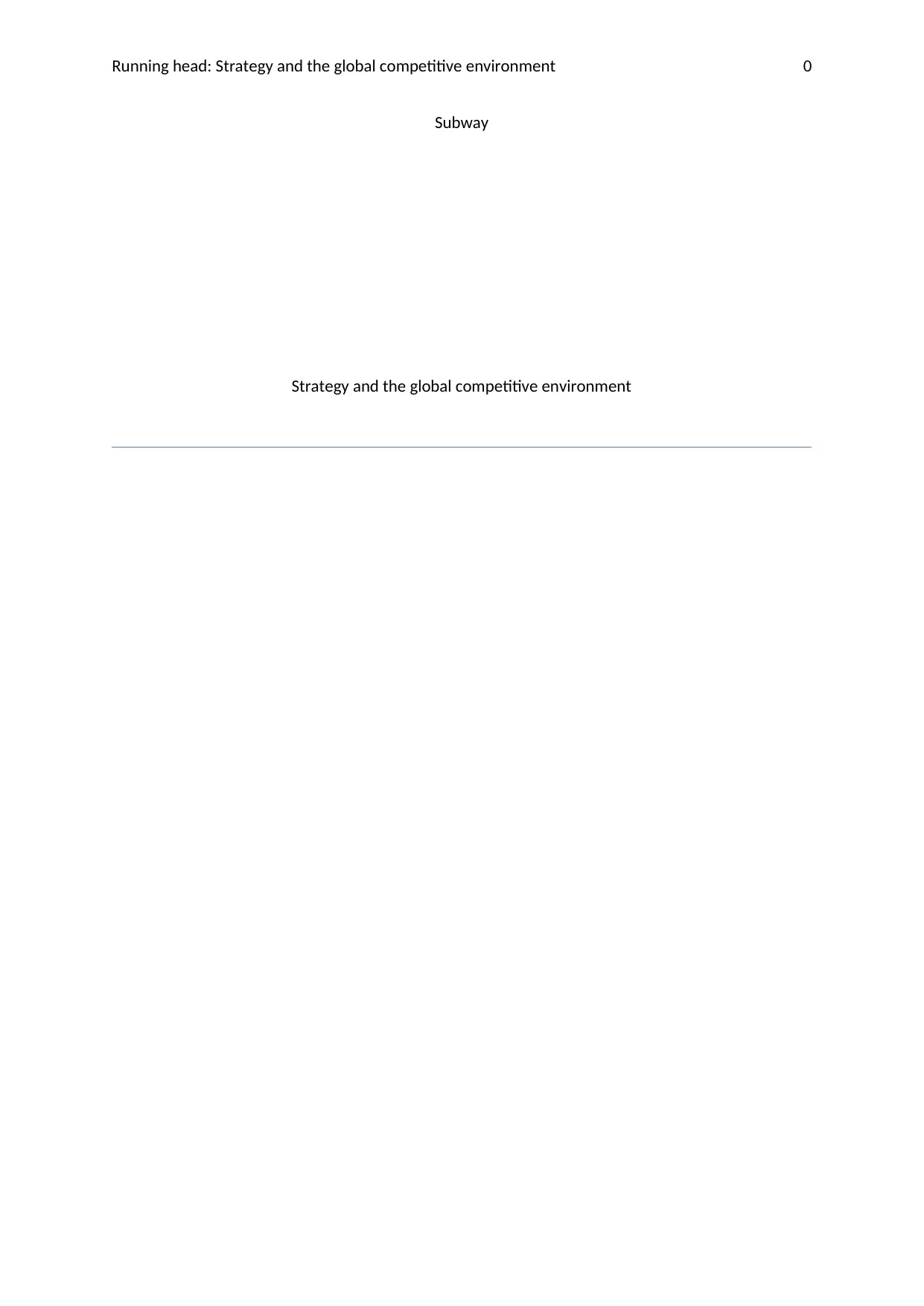
Running head: Strategy and the global competitive environment 0
Subway
Strategy and the global competitive environment
Subway
Strategy and the global competitive environment
Paraphrase This Document
Need a fresh take? Get an instant paraphrase of this document with our AI Paraphraser
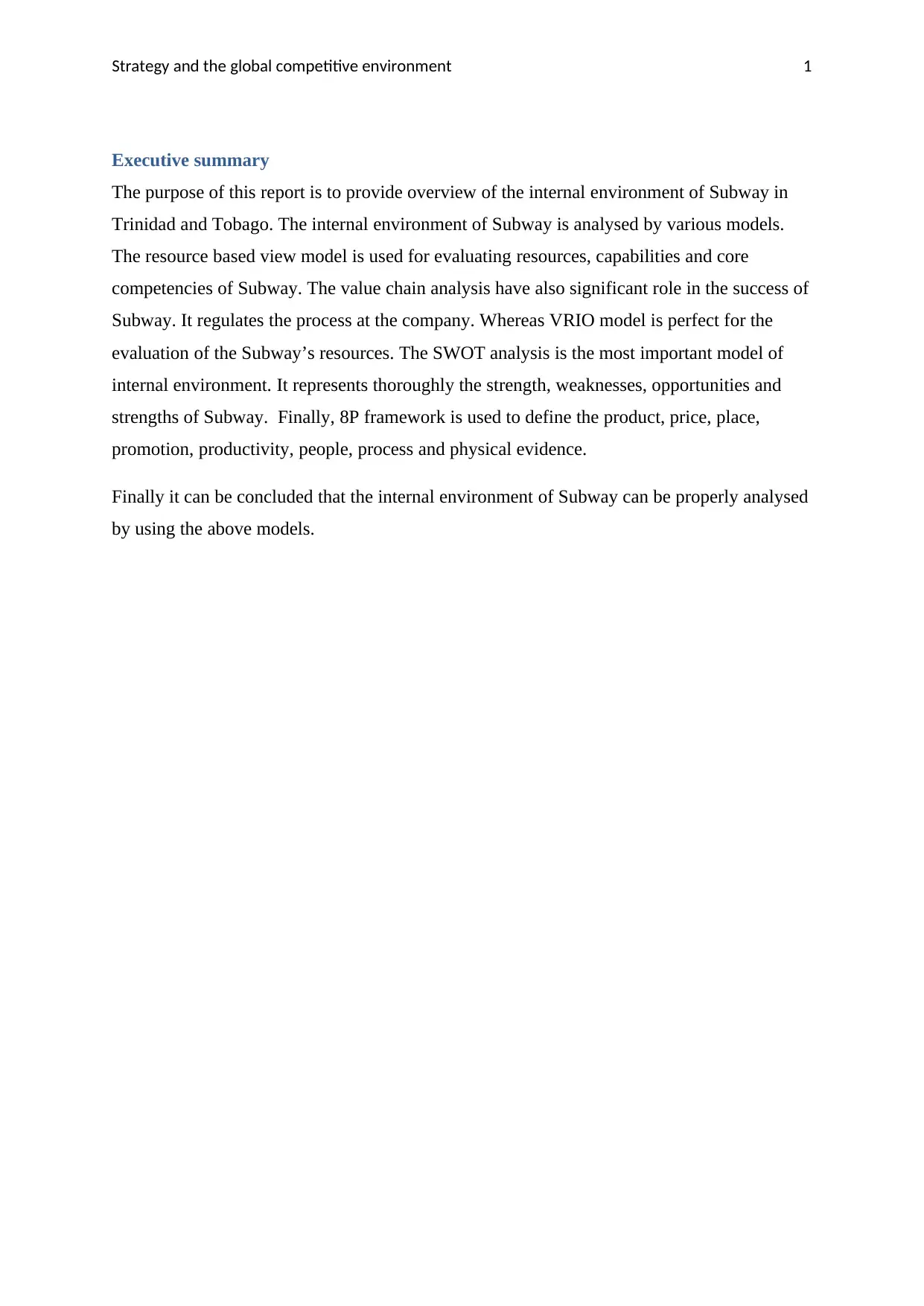
Strategy and the global competitive environment 1
Executive summary
The purpose of this report is to provide overview of the internal environment of Subway in
Trinidad and Tobago. The internal environment of Subway is analysed by various models.
The resource based view model is used for evaluating resources, capabilities and core
competencies of Subway. The value chain analysis have also significant role in the success of
Subway. It regulates the process at the company. Whereas VRIO model is perfect for the
evaluation of the Subway’s resources. The SWOT analysis is the most important model of
internal environment. It represents thoroughly the strength, weaknesses, opportunities and
strengths of Subway. Finally, 8P framework is used to define the product, price, place,
promotion, productivity, people, process and physical evidence.
Finally it can be concluded that the internal environment of Subway can be properly analysed
by using the above models.
Executive summary
The purpose of this report is to provide overview of the internal environment of Subway in
Trinidad and Tobago. The internal environment of Subway is analysed by various models.
The resource based view model is used for evaluating resources, capabilities and core
competencies of Subway. The value chain analysis have also significant role in the success of
Subway. It regulates the process at the company. Whereas VRIO model is perfect for the
evaluation of the Subway’s resources. The SWOT analysis is the most important model of
internal environment. It represents thoroughly the strength, weaknesses, opportunities and
strengths of Subway. Finally, 8P framework is used to define the product, price, place,
promotion, productivity, people, process and physical evidence.
Finally it can be concluded that the internal environment of Subway can be properly analysed
by using the above models.
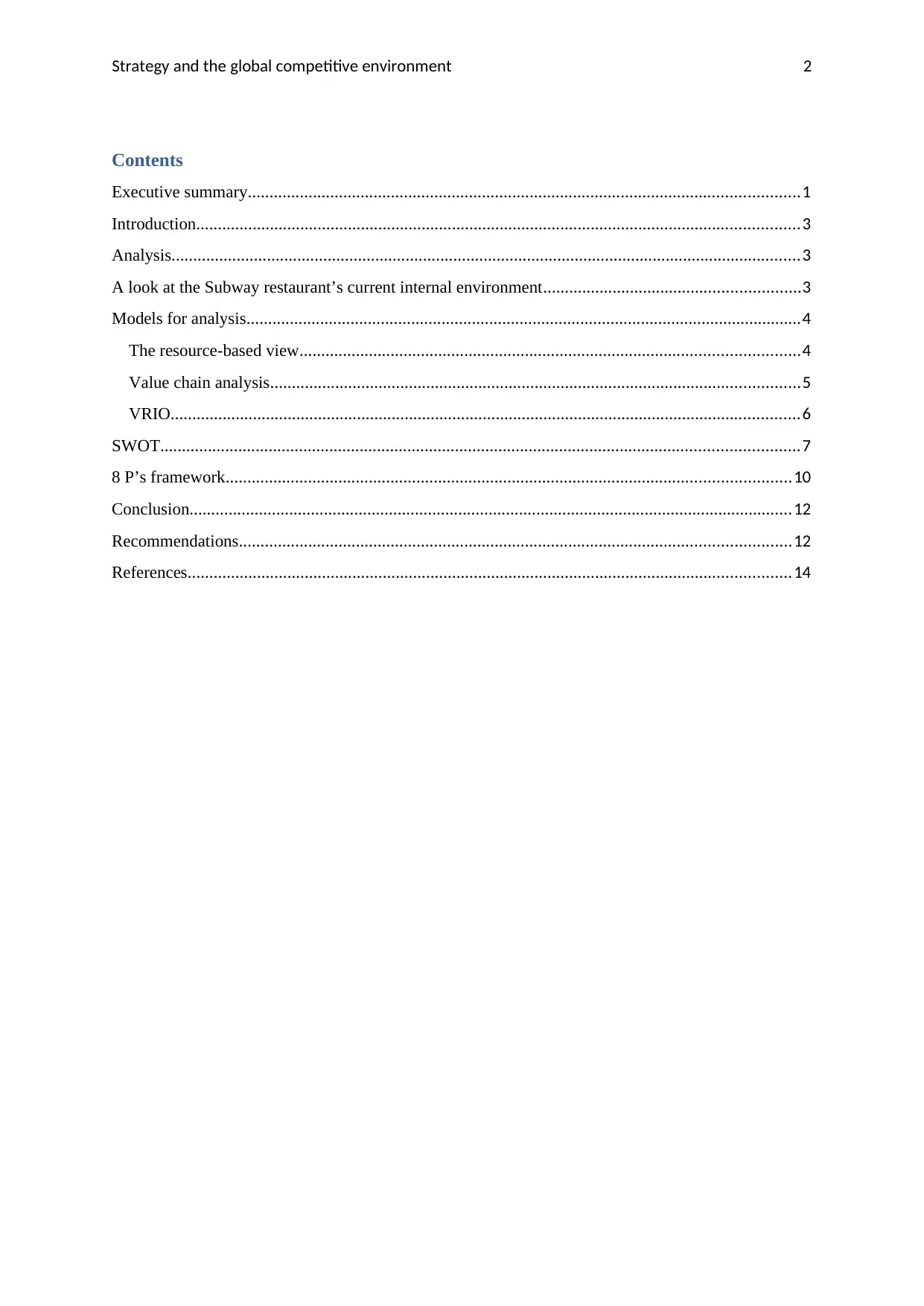
Strategy and the global competitive environment 2
Contents
Executive summary...............................................................................................................................1
Introduction...........................................................................................................................................3
Analysis.................................................................................................................................................3
A look at the Subway restaurant’s current internal environment...........................................................3
Models for analysis................................................................................................................................4
The resource-based view...................................................................................................................4
Value chain analysis..........................................................................................................................5
VRIO.................................................................................................................................................6
SWOT...................................................................................................................................................7
8 P’s framework..................................................................................................................................10
Conclusion...........................................................................................................................................12
Recommendations...............................................................................................................................12
References...........................................................................................................................................14
Contents
Executive summary...............................................................................................................................1
Introduction...........................................................................................................................................3
Analysis.................................................................................................................................................3
A look at the Subway restaurant’s current internal environment...........................................................3
Models for analysis................................................................................................................................4
The resource-based view...................................................................................................................4
Value chain analysis..........................................................................................................................5
VRIO.................................................................................................................................................6
SWOT...................................................................................................................................................7
8 P’s framework..................................................................................................................................10
Conclusion...........................................................................................................................................12
Recommendations...............................................................................................................................12
References...........................................................................................................................................14
⊘ This is a preview!⊘
Do you want full access?
Subscribe today to unlock all pages.

Trusted by 1+ million students worldwide
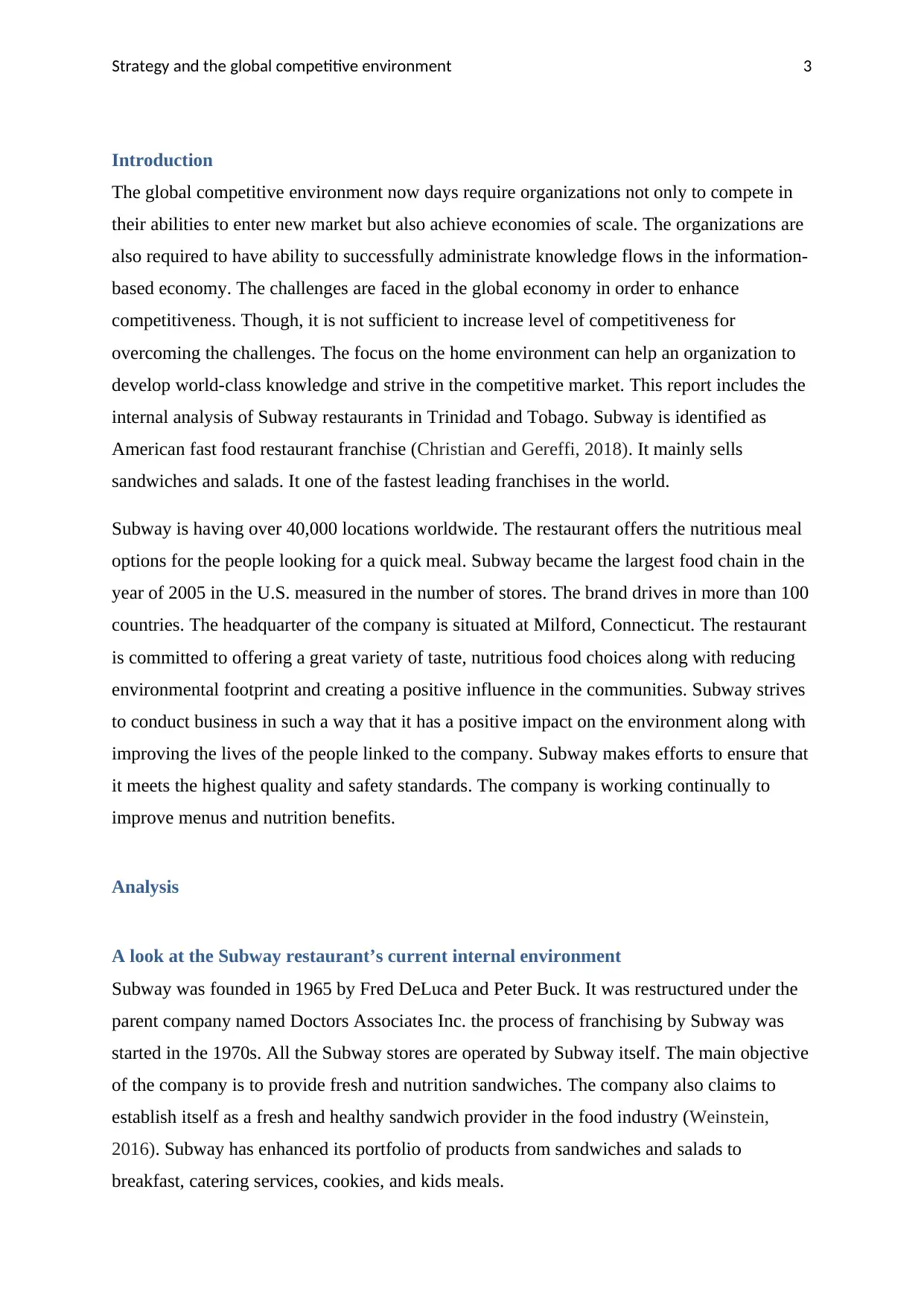
Strategy and the global competitive environment 3
Introduction
The global competitive environment now days require organizations not only to compete in
their abilities to enter new market but also achieve economies of scale. The organizations are
also required to have ability to successfully administrate knowledge flows in the information-
based economy. The challenges are faced in the global economy in order to enhance
competitiveness. Though, it is not sufficient to increase level of competitiveness for
overcoming the challenges. The focus on the home environment can help an organization to
develop world-class knowledge and strive in the competitive market. This report includes the
internal analysis of Subway restaurants in Trinidad and Tobago. Subway is identified as
American fast food restaurant franchise (Christian and Gereffi, 2018). It mainly sells
sandwiches and salads. It one of the fastest leading franchises in the world.
Subway is having over 40,000 locations worldwide. The restaurant offers the nutritious meal
options for the people looking for a quick meal. Subway became the largest food chain in the
year of 2005 in the U.S. measured in the number of stores. The brand drives in more than 100
countries. The headquarter of the company is situated at Milford, Connecticut. The restaurant
is committed to offering a great variety of taste, nutritious food choices along with reducing
environmental footprint and creating a positive influence in the communities. Subway strives
to conduct business in such a way that it has a positive impact on the environment along with
improving the lives of the people linked to the company. Subway makes efforts to ensure that
it meets the highest quality and safety standards. The company is working continually to
improve menus and nutrition benefits.
Analysis
A look at the Subway restaurant’s current internal environment
Subway was founded in 1965 by Fred DeLuca and Peter Buck. It was restructured under the
parent company named Doctors Associates Inc. the process of franchising by Subway was
started in the 1970s. All the Subway stores are operated by Subway itself. The main objective
of the company is to provide fresh and nutrition sandwiches. The company also claims to
establish itself as a fresh and healthy sandwich provider in the food industry (Weinstein,
2016). Subway has enhanced its portfolio of products from sandwiches and salads to
breakfast, catering services, cookies, and kids meals.
Introduction
The global competitive environment now days require organizations not only to compete in
their abilities to enter new market but also achieve economies of scale. The organizations are
also required to have ability to successfully administrate knowledge flows in the information-
based economy. The challenges are faced in the global economy in order to enhance
competitiveness. Though, it is not sufficient to increase level of competitiveness for
overcoming the challenges. The focus on the home environment can help an organization to
develop world-class knowledge and strive in the competitive market. This report includes the
internal analysis of Subway restaurants in Trinidad and Tobago. Subway is identified as
American fast food restaurant franchise (Christian and Gereffi, 2018). It mainly sells
sandwiches and salads. It one of the fastest leading franchises in the world.
Subway is having over 40,000 locations worldwide. The restaurant offers the nutritious meal
options for the people looking for a quick meal. Subway became the largest food chain in the
year of 2005 in the U.S. measured in the number of stores. The brand drives in more than 100
countries. The headquarter of the company is situated at Milford, Connecticut. The restaurant
is committed to offering a great variety of taste, nutritious food choices along with reducing
environmental footprint and creating a positive influence in the communities. Subway strives
to conduct business in such a way that it has a positive impact on the environment along with
improving the lives of the people linked to the company. Subway makes efforts to ensure that
it meets the highest quality and safety standards. The company is working continually to
improve menus and nutrition benefits.
Analysis
A look at the Subway restaurant’s current internal environment
Subway was founded in 1965 by Fred DeLuca and Peter Buck. It was restructured under the
parent company named Doctors Associates Inc. the process of franchising by Subway was
started in the 1970s. All the Subway stores are operated by Subway itself. The main objective
of the company is to provide fresh and nutrition sandwiches. The company also claims to
establish itself as a fresh and healthy sandwich provider in the food industry (Weinstein,
2016). Subway has enhanced its portfolio of products from sandwiches and salads to
breakfast, catering services, cookies, and kids meals.
Paraphrase This Document
Need a fresh take? Get an instant paraphrase of this document with our AI Paraphraser
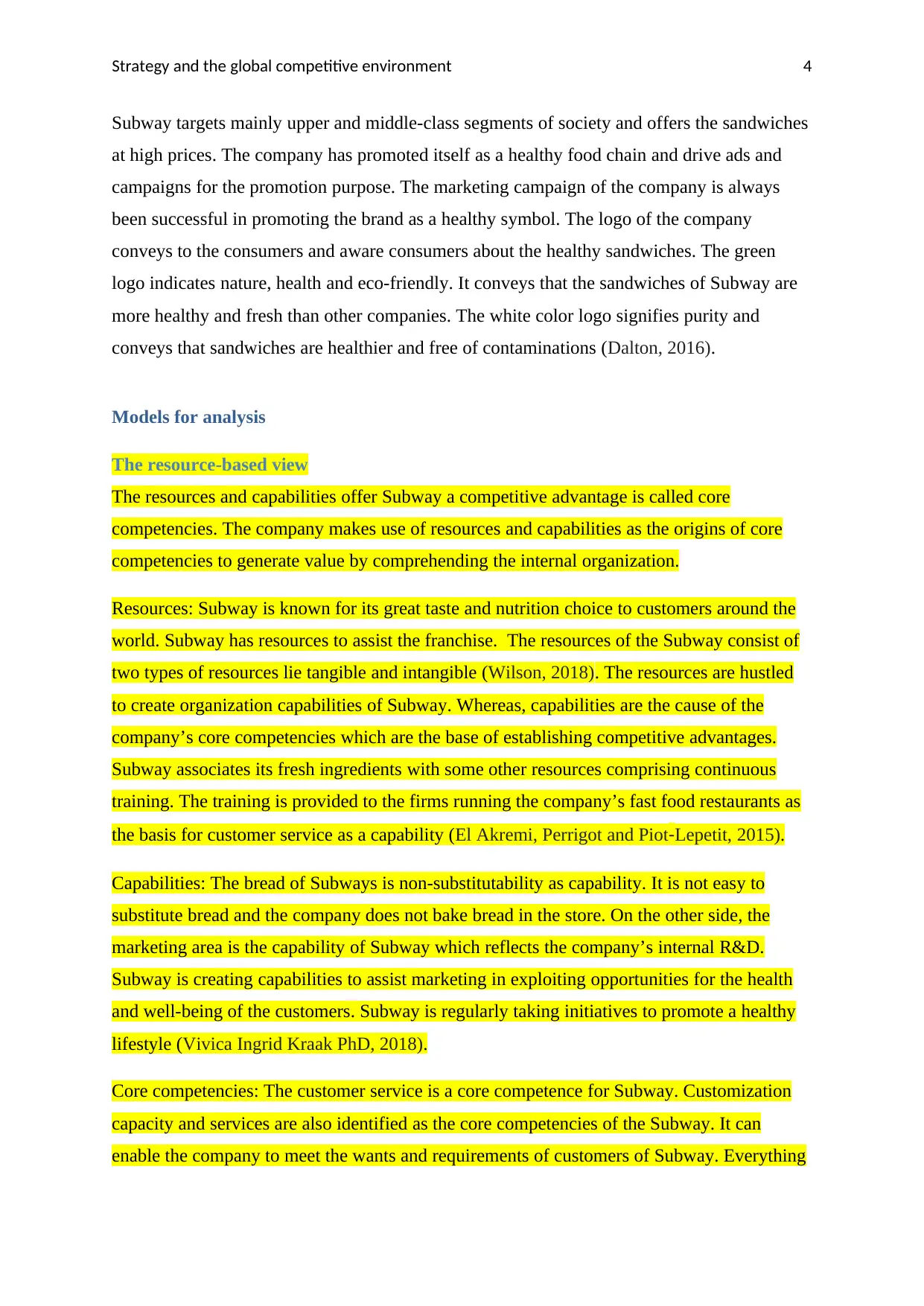
Strategy and the global competitive environment 4
Subway targets mainly upper and middle-class segments of society and offers the sandwiches
at high prices. The company has promoted itself as a healthy food chain and drive ads and
campaigns for the promotion purpose. The marketing campaign of the company is always
been successful in promoting the brand as a healthy symbol. The logo of the company
conveys to the consumers and aware consumers about the healthy sandwiches. The green
logo indicates nature, health and eco-friendly. It conveys that the sandwiches of Subway are
more healthy and fresh than other companies. The white color logo signifies purity and
conveys that sandwiches are healthier and free of contaminations (Dalton, 2016).
Models for analysis
The resource-based view
The resources and capabilities offer Subway a competitive advantage is called core
competencies. The company makes use of resources and capabilities as the origins of core
competencies to generate value by comprehending the internal organization.
Resources: Subway is known for its great taste and nutrition choice to customers around the
world. Subway has resources to assist the franchise. The resources of the Subway consist of
two types of resources lie tangible and intangible (Wilson, 2018). The resources are hustled
to create organization capabilities of Subway. Whereas, capabilities are the cause of the
company’s core competencies which are the base of establishing competitive advantages.
Subway associates its fresh ingredients with some other resources comprising continuous
training. The training is provided to the firms running the company’s fast food restaurants as
the basis for customer service as a capability (El Akremi, Perrigot and Piot‐Lepetit, 2015).
Capabilities: The bread of Subways is non-substitutability as capability. It is not easy to
substitute bread and the company does not bake bread in the store. On the other side, the
marketing area is the capability of Subway which reflects the company’s internal R&D.
Subway is creating capabilities to assist marketing in exploiting opportunities for the health
and well-being of the customers. Subway is regularly taking initiatives to promote a healthy
lifestyle (Vivica Ingrid Kraak PhD, 2018).
Core competencies: The customer service is a core competence for Subway. Customization
capacity and services are also identified as the core competencies of the Subway. It can
enable the company to meet the wants and requirements of customers of Subway. Everything
Subway targets mainly upper and middle-class segments of society and offers the sandwiches
at high prices. The company has promoted itself as a healthy food chain and drive ads and
campaigns for the promotion purpose. The marketing campaign of the company is always
been successful in promoting the brand as a healthy symbol. The logo of the company
conveys to the consumers and aware consumers about the healthy sandwiches. The green
logo indicates nature, health and eco-friendly. It conveys that the sandwiches of Subway are
more healthy and fresh than other companies. The white color logo signifies purity and
conveys that sandwiches are healthier and free of contaminations (Dalton, 2016).
Models for analysis
The resource-based view
The resources and capabilities offer Subway a competitive advantage is called core
competencies. The company makes use of resources and capabilities as the origins of core
competencies to generate value by comprehending the internal organization.
Resources: Subway is known for its great taste and nutrition choice to customers around the
world. Subway has resources to assist the franchise. The resources of the Subway consist of
two types of resources lie tangible and intangible (Wilson, 2018). The resources are hustled
to create organization capabilities of Subway. Whereas, capabilities are the cause of the
company’s core competencies which are the base of establishing competitive advantages.
Subway associates its fresh ingredients with some other resources comprising continuous
training. The training is provided to the firms running the company’s fast food restaurants as
the basis for customer service as a capability (El Akremi, Perrigot and Piot‐Lepetit, 2015).
Capabilities: The bread of Subways is non-substitutability as capability. It is not easy to
substitute bread and the company does not bake bread in the store. On the other side, the
marketing area is the capability of Subway which reflects the company’s internal R&D.
Subway is creating capabilities to assist marketing in exploiting opportunities for the health
and well-being of the customers. Subway is regularly taking initiatives to promote a healthy
lifestyle (Vivica Ingrid Kraak PhD, 2018).
Core competencies: The customer service is a core competence for Subway. Customization
capacity and services are also identified as the core competencies of the Subway. It can
enable the company to meet the wants and requirements of customers of Subway. Everything
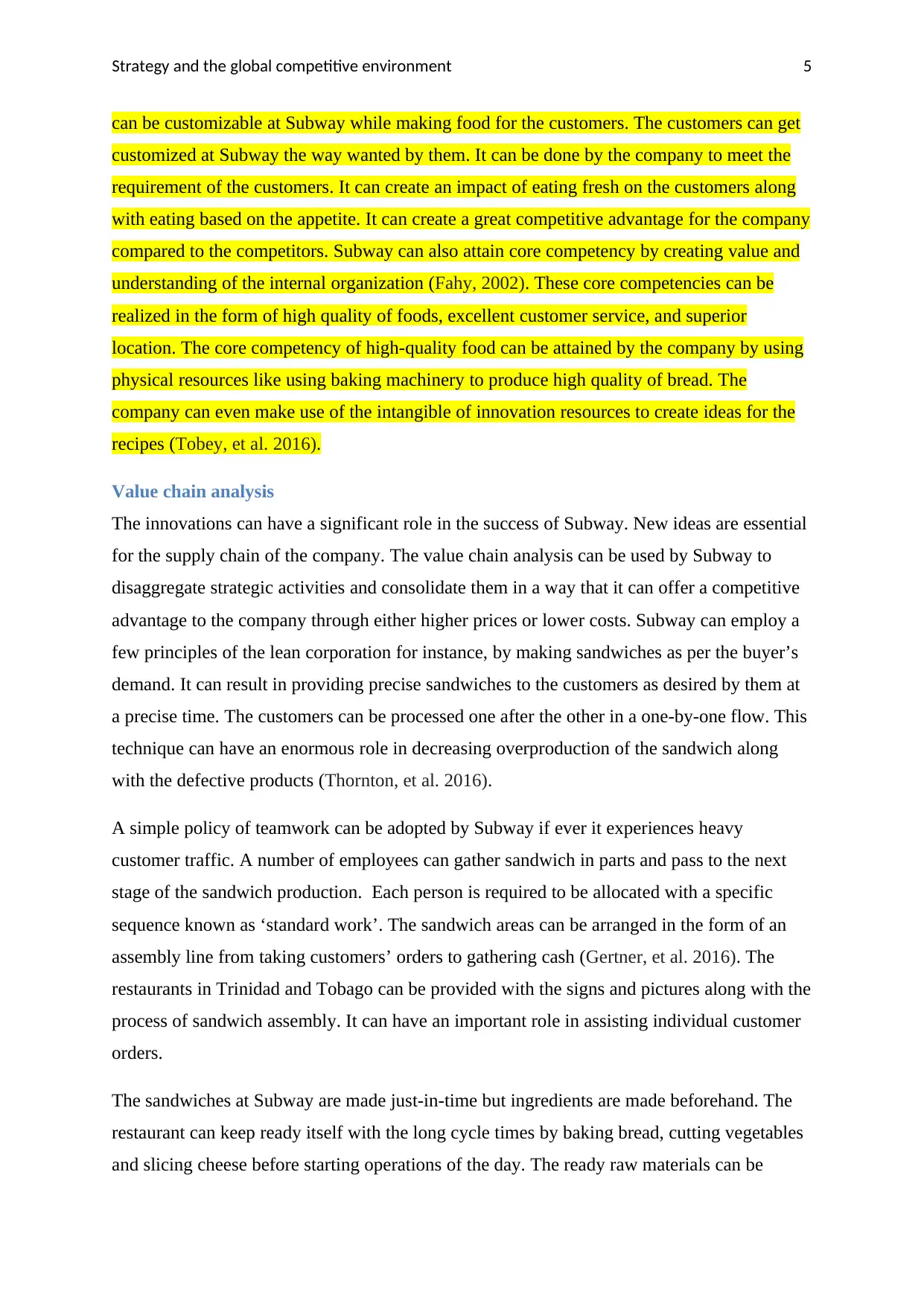
Strategy and the global competitive environment 5
can be customizable at Subway while making food for the customers. The customers can get
customized at Subway the way wanted by them. It can be done by the company to meet the
requirement of the customers. It can create an impact of eating fresh on the customers along
with eating based on the appetite. It can create a great competitive advantage for the company
compared to the competitors. Subway can also attain core competency by creating value and
understanding of the internal organization (Fahy, 2002). These core competencies can be
realized in the form of high quality of foods, excellent customer service, and superior
location. The core competency of high-quality food can be attained by the company by using
physical resources like using baking machinery to produce high quality of bread. The
company can even make use of the intangible of innovation resources to create ideas for the
recipes (Tobey, et al. 2016).
Value chain analysis
The innovations can have a significant role in the success of Subway. New ideas are essential
for the supply chain of the company. The value chain analysis can be used by Subway to
disaggregate strategic activities and consolidate them in a way that it can offer a competitive
advantage to the company through either higher prices or lower costs. Subway can employ a
few principles of the lean corporation for instance, by making sandwiches as per the buyer’s
demand. It can result in providing precise sandwiches to the customers as desired by them at
a precise time. The customers can be processed one after the other in a one-by-one flow. This
technique can have an enormous role in decreasing overproduction of the sandwich along
with the defective products (Thornton, et al. 2016).
A simple policy of teamwork can be adopted by Subway if ever it experiences heavy
customer traffic. A number of employees can gather sandwich in parts and pass to the next
stage of the sandwich production. Each person is required to be allocated with a specific
sequence known as ‘standard work’. The sandwich areas can be arranged in the form of an
assembly line from taking customers’ orders to gathering cash (Gertner, et al. 2016). The
restaurants in Trinidad and Tobago can be provided with the signs and pictures along with the
process of sandwich assembly. It can have an important role in assisting individual customer
orders.
The sandwiches at Subway are made just-in-time but ingredients are made beforehand. The
restaurant can keep ready itself with the long cycle times by baking bread, cutting vegetables
and slicing cheese before starting operations of the day. The ready raw materials can be
can be customizable at Subway while making food for the customers. The customers can get
customized at Subway the way wanted by them. It can be done by the company to meet the
requirement of the customers. It can create an impact of eating fresh on the customers along
with eating based on the appetite. It can create a great competitive advantage for the company
compared to the competitors. Subway can also attain core competency by creating value and
understanding of the internal organization (Fahy, 2002). These core competencies can be
realized in the form of high quality of foods, excellent customer service, and superior
location. The core competency of high-quality food can be attained by the company by using
physical resources like using baking machinery to produce high quality of bread. The
company can even make use of the intangible of innovation resources to create ideas for the
recipes (Tobey, et al. 2016).
Value chain analysis
The innovations can have a significant role in the success of Subway. New ideas are essential
for the supply chain of the company. The value chain analysis can be used by Subway to
disaggregate strategic activities and consolidate them in a way that it can offer a competitive
advantage to the company through either higher prices or lower costs. Subway can employ a
few principles of the lean corporation for instance, by making sandwiches as per the buyer’s
demand. It can result in providing precise sandwiches to the customers as desired by them at
a precise time. The customers can be processed one after the other in a one-by-one flow. This
technique can have an enormous role in decreasing overproduction of the sandwich along
with the defective products (Thornton, et al. 2016).
A simple policy of teamwork can be adopted by Subway if ever it experiences heavy
customer traffic. A number of employees can gather sandwich in parts and pass to the next
stage of the sandwich production. Each person is required to be allocated with a specific
sequence known as ‘standard work’. The sandwich areas can be arranged in the form of an
assembly line from taking customers’ orders to gathering cash (Gertner, et al. 2016). The
restaurants in Trinidad and Tobago can be provided with the signs and pictures along with the
process of sandwich assembly. It can have an important role in assisting individual customer
orders.
The sandwiches at Subway are made just-in-time but ingredients are made beforehand. The
restaurant can keep ready itself with the long cycle times by baking bread, cutting vegetables
and slicing cheese before starting operations of the day. The ready raw materials can be
⊘ This is a preview!⊘
Do you want full access?
Subscribe today to unlock all pages.

Trusted by 1+ million students worldwide
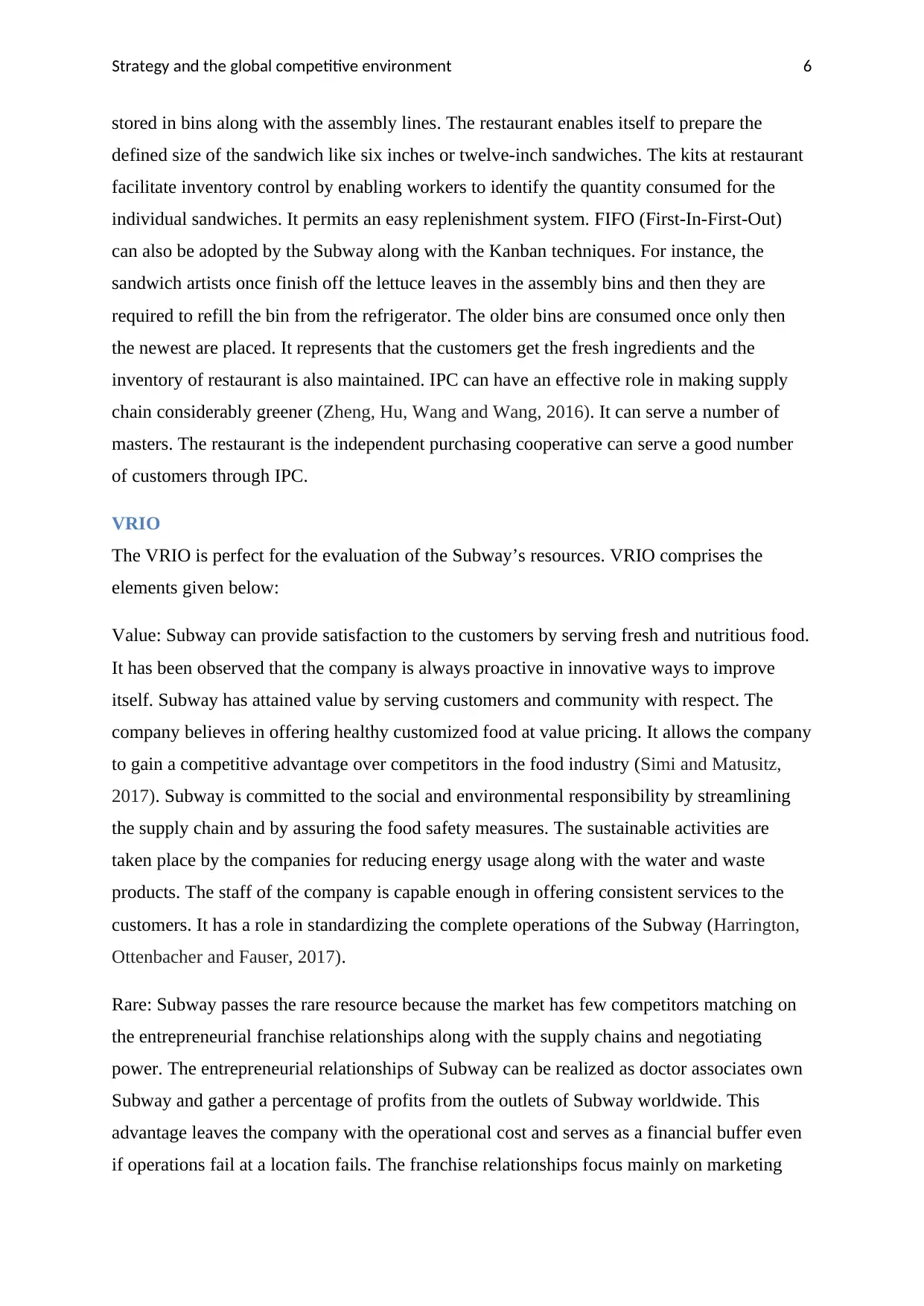
Strategy and the global competitive environment 6
stored in bins along with the assembly lines. The restaurant enables itself to prepare the
defined size of the sandwich like six inches or twelve-inch sandwiches. The kits at restaurant
facilitate inventory control by enabling workers to identify the quantity consumed for the
individual sandwiches. It permits an easy replenishment system. FIFO (First-In-First-Out)
can also be adopted by the Subway along with the Kanban techniques. For instance, the
sandwich artists once finish off the lettuce leaves in the assembly bins and then they are
required to refill the bin from the refrigerator. The older bins are consumed once only then
the newest are placed. It represents that the customers get the fresh ingredients and the
inventory of restaurant is also maintained. IPC can have an effective role in making supply
chain considerably greener (Zheng, Hu, Wang and Wang, 2016). It can serve a number of
masters. The restaurant is the independent purchasing cooperative can serve a good number
of customers through IPC.
VRIO
The VRIO is perfect for the evaluation of the Subway’s resources. VRIO comprises the
elements given below:
Value: Subway can provide satisfaction to the customers by serving fresh and nutritious food.
It has been observed that the company is always proactive in innovative ways to improve
itself. Subway has attained value by serving customers and community with respect. The
company believes in offering healthy customized food at value pricing. It allows the company
to gain a competitive advantage over competitors in the food industry (Simi and Matusitz,
2017). Subway is committed to the social and environmental responsibility by streamlining
the supply chain and by assuring the food safety measures. The sustainable activities are
taken place by the companies for reducing energy usage along with the water and waste
products. The staff of the company is capable enough in offering consistent services to the
customers. It has a role in standardizing the complete operations of the Subway (Harrington,
Ottenbacher and Fauser, 2017).
Rare: Subway passes the rare resource because the market has few competitors matching on
the entrepreneurial franchise relationships along with the supply chains and negotiating
power. The entrepreneurial relationships of Subway can be realized as doctor associates own
Subway and gather a percentage of profits from the outlets of Subway worldwide. This
advantage leaves the company with the operational cost and serves as a financial buffer even
if operations fail at a location fails. The franchise relationships focus mainly on marketing
stored in bins along with the assembly lines. The restaurant enables itself to prepare the
defined size of the sandwich like six inches or twelve-inch sandwiches. The kits at restaurant
facilitate inventory control by enabling workers to identify the quantity consumed for the
individual sandwiches. It permits an easy replenishment system. FIFO (First-In-First-Out)
can also be adopted by the Subway along with the Kanban techniques. For instance, the
sandwich artists once finish off the lettuce leaves in the assembly bins and then they are
required to refill the bin from the refrigerator. The older bins are consumed once only then
the newest are placed. It represents that the customers get the fresh ingredients and the
inventory of restaurant is also maintained. IPC can have an effective role in making supply
chain considerably greener (Zheng, Hu, Wang and Wang, 2016). It can serve a number of
masters. The restaurant is the independent purchasing cooperative can serve a good number
of customers through IPC.
VRIO
The VRIO is perfect for the evaluation of the Subway’s resources. VRIO comprises the
elements given below:
Value: Subway can provide satisfaction to the customers by serving fresh and nutritious food.
It has been observed that the company is always proactive in innovative ways to improve
itself. Subway has attained value by serving customers and community with respect. The
company believes in offering healthy customized food at value pricing. It allows the company
to gain a competitive advantage over competitors in the food industry (Simi and Matusitz,
2017). Subway is committed to the social and environmental responsibility by streamlining
the supply chain and by assuring the food safety measures. The sustainable activities are
taken place by the companies for reducing energy usage along with the water and waste
products. The staff of the company is capable enough in offering consistent services to the
customers. It has a role in standardizing the complete operations of the Subway (Harrington,
Ottenbacher and Fauser, 2017).
Rare: Subway passes the rare resource because the market has few competitors matching on
the entrepreneurial franchise relationships along with the supply chains and negotiating
power. The entrepreneurial relationships of Subway can be realized as doctor associates own
Subway and gather a percentage of profits from the outlets of Subway worldwide. This
advantage leaves the company with the operational cost and serves as a financial buffer even
if operations fail at a location fails. The franchise relationships focus mainly on marketing
Paraphrase This Document
Need a fresh take? Get an instant paraphrase of this document with our AI Paraphraser
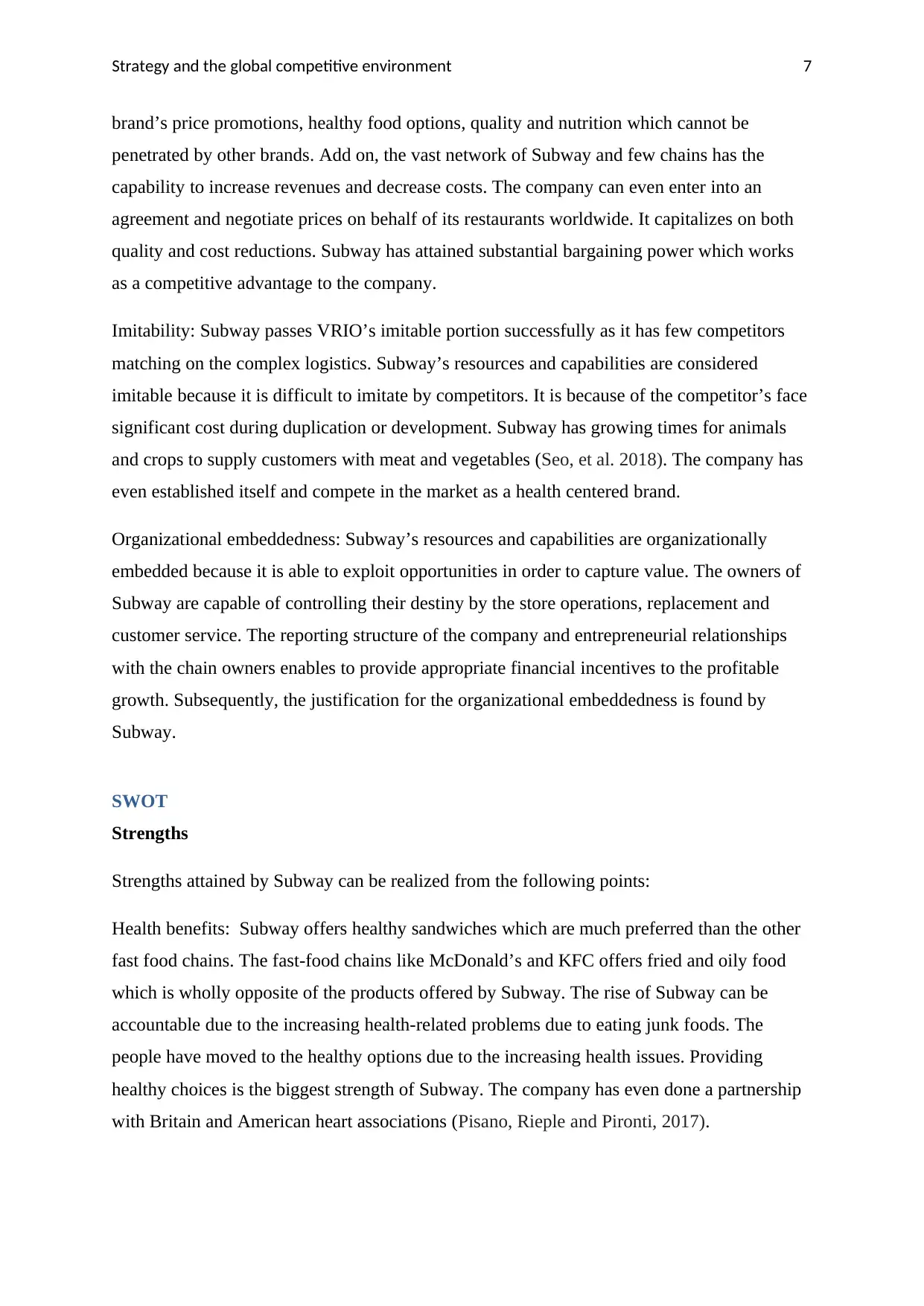
Strategy and the global competitive environment 7
brand’s price promotions, healthy food options, quality and nutrition which cannot be
penetrated by other brands. Add on, the vast network of Subway and few chains has the
capability to increase revenues and decrease costs. The company can even enter into an
agreement and negotiate prices on behalf of its restaurants worldwide. It capitalizes on both
quality and cost reductions. Subway has attained substantial bargaining power which works
as a competitive advantage to the company.
Imitability: Subway passes VRIO’s imitable portion successfully as it has few competitors
matching on the complex logistics. Subway’s resources and capabilities are considered
imitable because it is difficult to imitate by competitors. It is because of the competitor’s face
significant cost during duplication or development. Subway has growing times for animals
and crops to supply customers with meat and vegetables (Seo, et al. 2018). The company has
even established itself and compete in the market as a health centered brand.
Organizational embeddedness: Subway’s resources and capabilities are organizationally
embedded because it is able to exploit opportunities in order to capture value. The owners of
Subway are capable of controlling their destiny by the store operations, replacement and
customer service. The reporting structure of the company and entrepreneurial relationships
with the chain owners enables to provide appropriate financial incentives to the profitable
growth. Subsequently, the justification for the organizational embeddedness is found by
Subway.
SWOT
Strengths
Strengths attained by Subway can be realized from the following points:
Health benefits: Subway offers healthy sandwiches which are much preferred than the other
fast food chains. The fast-food chains like McDonald’s and KFC offers fried and oily food
which is wholly opposite of the products offered by Subway. The rise of Subway can be
accountable due to the increasing health-related problems due to eating junk foods. The
people have moved to the healthy options due to the increasing health issues. Providing
healthy choices is the biggest strength of Subway. The company has even done a partnership
with Britain and American heart associations (Pisano, Rieple and Pironti, 2017).
brand’s price promotions, healthy food options, quality and nutrition which cannot be
penetrated by other brands. Add on, the vast network of Subway and few chains has the
capability to increase revenues and decrease costs. The company can even enter into an
agreement and negotiate prices on behalf of its restaurants worldwide. It capitalizes on both
quality and cost reductions. Subway has attained substantial bargaining power which works
as a competitive advantage to the company.
Imitability: Subway passes VRIO’s imitable portion successfully as it has few competitors
matching on the complex logistics. Subway’s resources and capabilities are considered
imitable because it is difficult to imitate by competitors. It is because of the competitor’s face
significant cost during duplication or development. Subway has growing times for animals
and crops to supply customers with meat and vegetables (Seo, et al. 2018). The company has
even established itself and compete in the market as a health centered brand.
Organizational embeddedness: Subway’s resources and capabilities are organizationally
embedded because it is able to exploit opportunities in order to capture value. The owners of
Subway are capable of controlling their destiny by the store operations, replacement and
customer service. The reporting structure of the company and entrepreneurial relationships
with the chain owners enables to provide appropriate financial incentives to the profitable
growth. Subsequently, the justification for the organizational embeddedness is found by
Subway.
SWOT
Strengths
Strengths attained by Subway can be realized from the following points:
Health benefits: Subway offers healthy sandwiches which are much preferred than the other
fast food chains. The fast-food chains like McDonald’s and KFC offers fried and oily food
which is wholly opposite of the products offered by Subway. The rise of Subway can be
accountable due to the increasing health-related problems due to eating junk foods. The
people have moved to the healthy options due to the increasing health issues. Providing
healthy choices is the biggest strength of Subway. The company has even done a partnership
with Britain and American heart associations (Pisano, Rieple and Pironti, 2017).
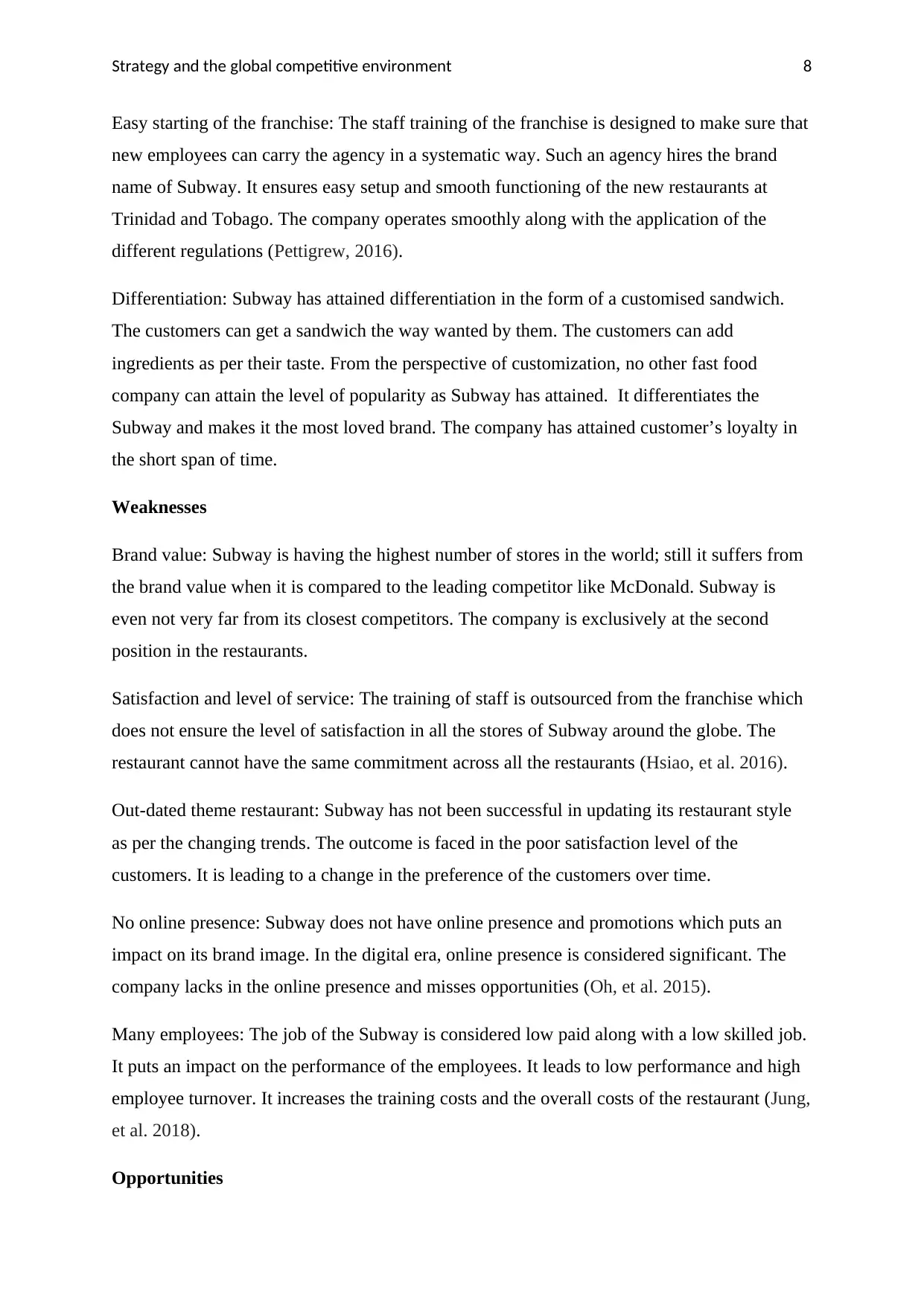
Strategy and the global competitive environment 8
Easy starting of the franchise: The staff training of the franchise is designed to make sure that
new employees can carry the agency in a systematic way. Such an agency hires the brand
name of Subway. It ensures easy setup and smooth functioning of the new restaurants at
Trinidad and Tobago. The company operates smoothly along with the application of the
different regulations (Pettigrew, 2016).
Differentiation: Subway has attained differentiation in the form of a customised sandwich.
The customers can get a sandwich the way wanted by them. The customers can add
ingredients as per their taste. From the perspective of customization, no other fast food
company can attain the level of popularity as Subway has attained. It differentiates the
Subway and makes it the most loved brand. The company has attained customer’s loyalty in
the short span of time.
Weaknesses
Brand value: Subway is having the highest number of stores in the world; still it suffers from
the brand value when it is compared to the leading competitor like McDonald. Subway is
even not very far from its closest competitors. The company is exclusively at the second
position in the restaurants.
Satisfaction and level of service: The training of staff is outsourced from the franchise which
does not ensure the level of satisfaction in all the stores of Subway around the globe. The
restaurant cannot have the same commitment across all the restaurants (Hsiao, et al. 2016).
Out-dated theme restaurant: Subway has not been successful in updating its restaurant style
as per the changing trends. The outcome is faced in the poor satisfaction level of the
customers. It is leading to a change in the preference of the customers over time.
No online presence: Subway does not have online presence and promotions which puts an
impact on its brand image. In the digital era, online presence is considered significant. The
company lacks in the online presence and misses opportunities (Oh, et al. 2015).
Many employees: The job of the Subway is considered low paid along with a low skilled job.
It puts an impact on the performance of the employees. It leads to low performance and high
employee turnover. It increases the training costs and the overall costs of the restaurant (Jung,
et al. 2018).
Opportunities
Easy starting of the franchise: The staff training of the franchise is designed to make sure that
new employees can carry the agency in a systematic way. Such an agency hires the brand
name of Subway. It ensures easy setup and smooth functioning of the new restaurants at
Trinidad and Tobago. The company operates smoothly along with the application of the
different regulations (Pettigrew, 2016).
Differentiation: Subway has attained differentiation in the form of a customised sandwich.
The customers can get a sandwich the way wanted by them. The customers can add
ingredients as per their taste. From the perspective of customization, no other fast food
company can attain the level of popularity as Subway has attained. It differentiates the
Subway and makes it the most loved brand. The company has attained customer’s loyalty in
the short span of time.
Weaknesses
Brand value: Subway is having the highest number of stores in the world; still it suffers from
the brand value when it is compared to the leading competitor like McDonald. Subway is
even not very far from its closest competitors. The company is exclusively at the second
position in the restaurants.
Satisfaction and level of service: The training of staff is outsourced from the franchise which
does not ensure the level of satisfaction in all the stores of Subway around the globe. The
restaurant cannot have the same commitment across all the restaurants (Hsiao, et al. 2016).
Out-dated theme restaurant: Subway has not been successful in updating its restaurant style
as per the changing trends. The outcome is faced in the poor satisfaction level of the
customers. It is leading to a change in the preference of the customers over time.
No online presence: Subway does not have online presence and promotions which puts an
impact on its brand image. In the digital era, online presence is considered significant. The
company lacks in the online presence and misses opportunities (Oh, et al. 2015).
Many employees: The job of the Subway is considered low paid along with a low skilled job.
It puts an impact on the performance of the employees. It leads to low performance and high
employee turnover. It increases the training costs and the overall costs of the restaurant (Jung,
et al. 2018).
Opportunities
⊘ This is a preview!⊘
Do you want full access?
Subscribe today to unlock all pages.

Trusted by 1+ million students worldwide
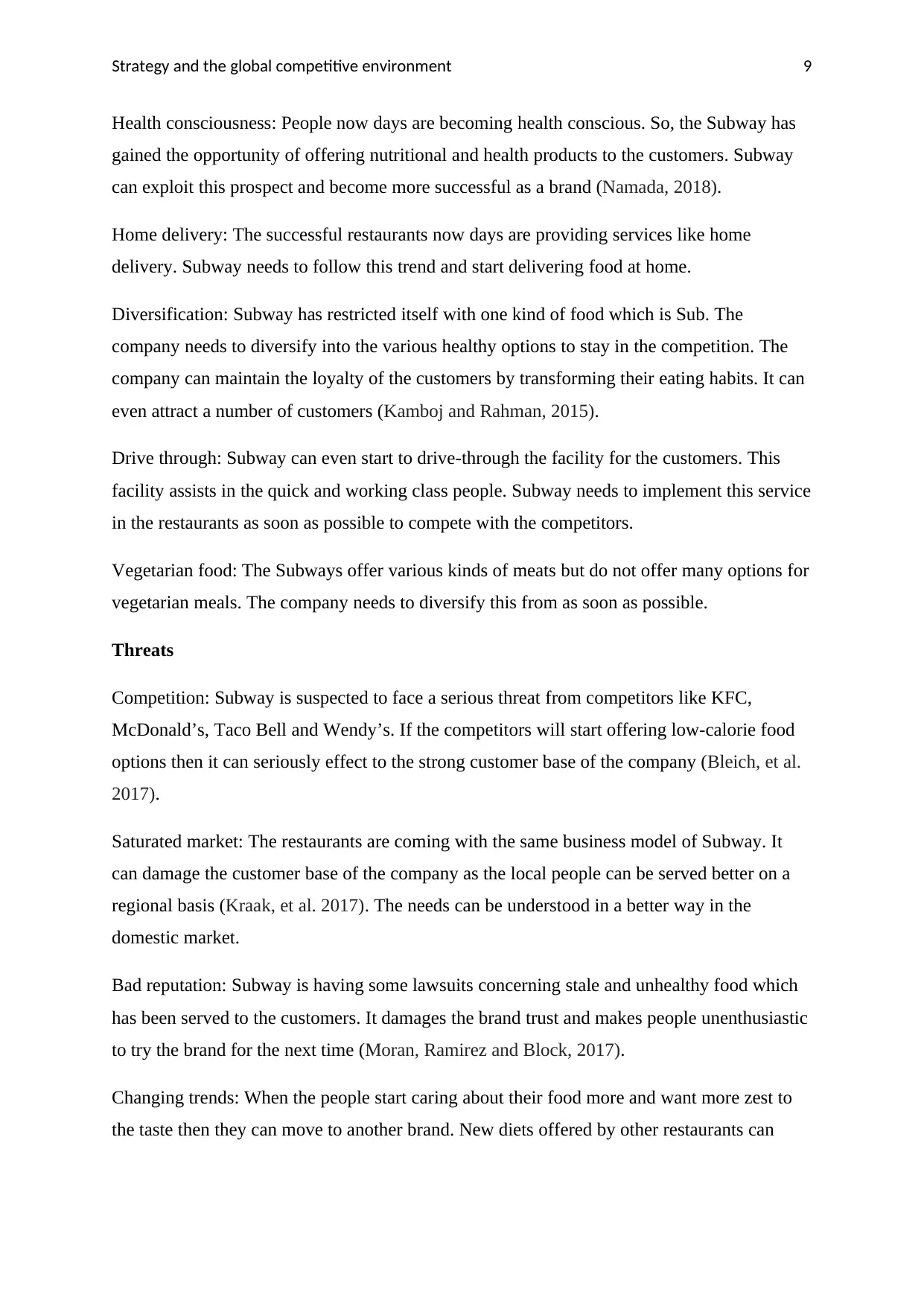
Strategy and the global competitive environment 9
Health consciousness: People now days are becoming health conscious. So, the Subway has
gained the opportunity of offering nutritional and health products to the customers. Subway
can exploit this prospect and become more successful as a brand (Namada, 2018).
Home delivery: The successful restaurants now days are providing services like home
delivery. Subway needs to follow this trend and start delivering food at home.
Diversification: Subway has restricted itself with one kind of food which is Sub. The
company needs to diversify into the various healthy options to stay in the competition. The
company can maintain the loyalty of the customers by transforming their eating habits. It can
even attract a number of customers (Kamboj and Rahman, 2015).
Drive through: Subway can even start to drive-through the facility for the customers. This
facility assists in the quick and working class people. Subway needs to implement this service
in the restaurants as soon as possible to compete with the competitors.
Vegetarian food: The Subways offer various kinds of meats but do not offer many options for
vegetarian meals. The company needs to diversify this from as soon as possible.
Threats
Competition: Subway is suspected to face a serious threat from competitors like KFC,
McDonald’s, Taco Bell and Wendy’s. If the competitors will start offering low-calorie food
options then it can seriously effect to the strong customer base of the company (Bleich, et al.
2017).
Saturated market: The restaurants are coming with the same business model of Subway. It
can damage the customer base of the company as the local people can be served better on a
regional basis (Kraak, et al. 2017). The needs can be understood in a better way in the
domestic market.
Bad reputation: Subway is having some lawsuits concerning stale and unhealthy food which
has been served to the customers. It damages the brand trust and makes people unenthusiastic
to try the brand for the next time (Moran, Ramirez and Block, 2017).
Changing trends: When the people start caring about their food more and want more zest to
the taste then they can move to another brand. New diets offered by other restaurants can
Health consciousness: People now days are becoming health conscious. So, the Subway has
gained the opportunity of offering nutritional and health products to the customers. Subway
can exploit this prospect and become more successful as a brand (Namada, 2018).
Home delivery: The successful restaurants now days are providing services like home
delivery. Subway needs to follow this trend and start delivering food at home.
Diversification: Subway has restricted itself with one kind of food which is Sub. The
company needs to diversify into the various healthy options to stay in the competition. The
company can maintain the loyalty of the customers by transforming their eating habits. It can
even attract a number of customers (Kamboj and Rahman, 2015).
Drive through: Subway can even start to drive-through the facility for the customers. This
facility assists in the quick and working class people. Subway needs to implement this service
in the restaurants as soon as possible to compete with the competitors.
Vegetarian food: The Subways offer various kinds of meats but do not offer many options for
vegetarian meals. The company needs to diversify this from as soon as possible.
Threats
Competition: Subway is suspected to face a serious threat from competitors like KFC,
McDonald’s, Taco Bell and Wendy’s. If the competitors will start offering low-calorie food
options then it can seriously effect to the strong customer base of the company (Bleich, et al.
2017).
Saturated market: The restaurants are coming with the same business model of Subway. It
can damage the customer base of the company as the local people can be served better on a
regional basis (Kraak, et al. 2017). The needs can be understood in a better way in the
domestic market.
Bad reputation: Subway is having some lawsuits concerning stale and unhealthy food which
has been served to the customers. It damages the brand trust and makes people unenthusiastic
to try the brand for the next time (Moran, Ramirez and Block, 2017).
Changing trends: When the people start caring about their food more and want more zest to
the taste then they can move to another brand. New diets offered by other restaurants can
Paraphrase This Document
Need a fresh take? Get an instant paraphrase of this document with our AI Paraphraser
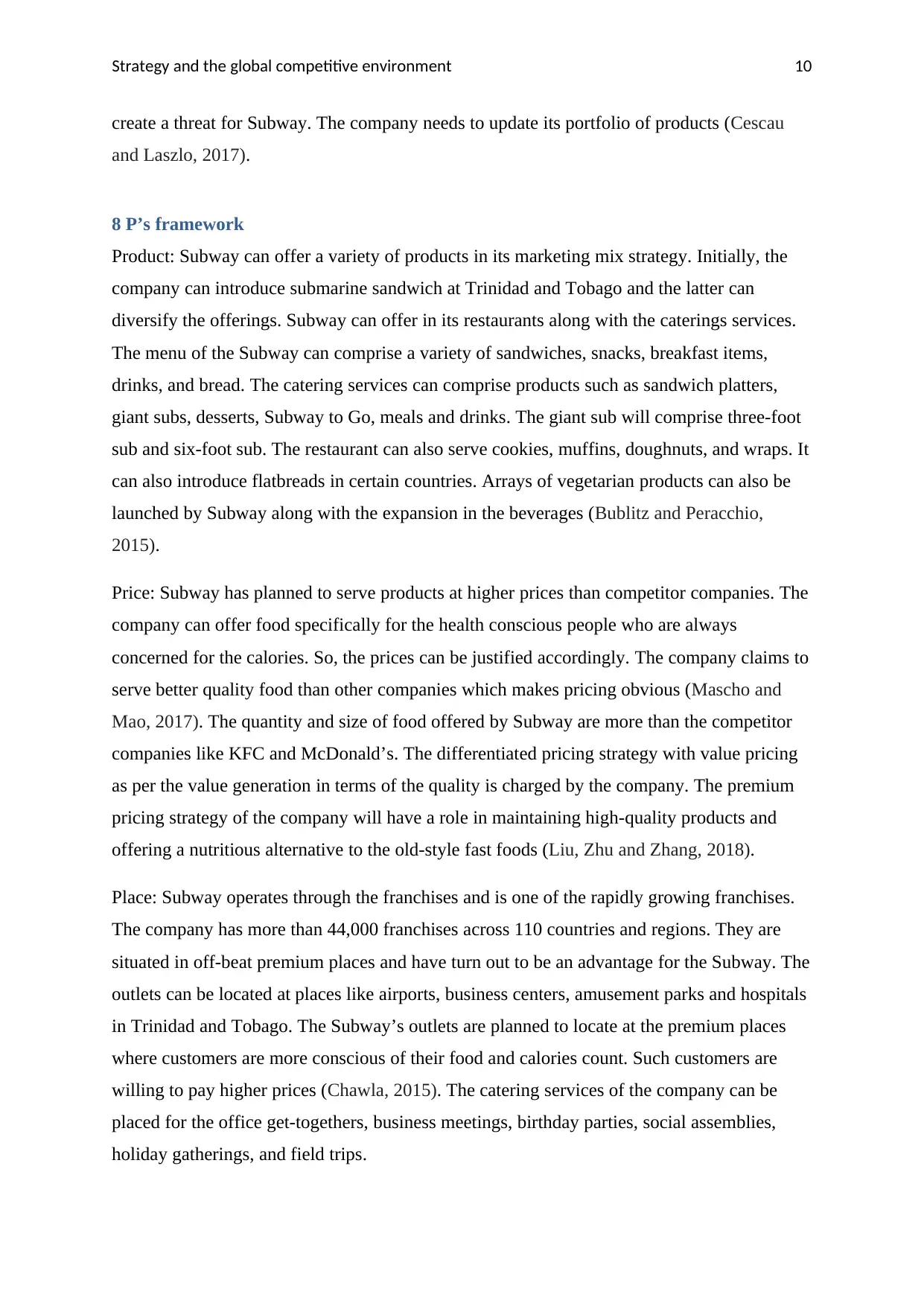
Strategy and the global competitive environment 10
create a threat for Subway. The company needs to update its portfolio of products (Cescau
and Laszlo, 2017).
8 P’s framework
Product: Subway can offer a variety of products in its marketing mix strategy. Initially, the
company can introduce submarine sandwich at Trinidad and Tobago and the latter can
diversify the offerings. Subway can offer in its restaurants along with the caterings services.
The menu of the Subway can comprise a variety of sandwiches, snacks, breakfast items,
drinks, and bread. The catering services can comprise products such as sandwich platters,
giant subs, desserts, Subway to Go, meals and drinks. The giant sub will comprise three-foot
sub and six-foot sub. The restaurant can also serve cookies, muffins, doughnuts, and wraps. It
can also introduce flatbreads in certain countries. Arrays of vegetarian products can also be
launched by Subway along with the expansion in the beverages (Bublitz and Peracchio,
2015).
Price: Subway has planned to serve products at higher prices than competitor companies. The
company can offer food specifically for the health conscious people who are always
concerned for the calories. So, the prices can be justified accordingly. The company claims to
serve better quality food than other companies which makes pricing obvious (Mascho and
Mao, 2017). The quantity and size of food offered by Subway are more than the competitor
companies like KFC and McDonald’s. The differentiated pricing strategy with value pricing
as per the value generation in terms of the quality is charged by the company. The premium
pricing strategy of the company will have a role in maintaining high-quality products and
offering a nutritious alternative to the old-style fast foods (Liu, Zhu and Zhang, 2018).
Place: Subway operates through the franchises and is one of the rapidly growing franchises.
The company has more than 44,000 franchises across 110 countries and regions. They are
situated in off-beat premium places and have turn out to be an advantage for the Subway. The
outlets can be located at places like airports, business centers, amusement parks and hospitals
in Trinidad and Tobago. The Subway’s outlets are planned to locate at the premium places
where customers are more conscious of their food and calories count. Such customers are
willing to pay higher prices (Chawla, 2015). The catering services of the company can be
placed for the office get-togethers, business meetings, birthday parties, social assemblies,
holiday gatherings, and field trips.
create a threat for Subway. The company needs to update its portfolio of products (Cescau
and Laszlo, 2017).
8 P’s framework
Product: Subway can offer a variety of products in its marketing mix strategy. Initially, the
company can introduce submarine sandwich at Trinidad and Tobago and the latter can
diversify the offerings. Subway can offer in its restaurants along with the caterings services.
The menu of the Subway can comprise a variety of sandwiches, snacks, breakfast items,
drinks, and bread. The catering services can comprise products such as sandwich platters,
giant subs, desserts, Subway to Go, meals and drinks. The giant sub will comprise three-foot
sub and six-foot sub. The restaurant can also serve cookies, muffins, doughnuts, and wraps. It
can also introduce flatbreads in certain countries. Arrays of vegetarian products can also be
launched by Subway along with the expansion in the beverages (Bublitz and Peracchio,
2015).
Price: Subway has planned to serve products at higher prices than competitor companies. The
company can offer food specifically for the health conscious people who are always
concerned for the calories. So, the prices can be justified accordingly. The company claims to
serve better quality food than other companies which makes pricing obvious (Mascho and
Mao, 2017). The quantity and size of food offered by Subway are more than the competitor
companies like KFC and McDonald’s. The differentiated pricing strategy with value pricing
as per the value generation in terms of the quality is charged by the company. The premium
pricing strategy of the company will have a role in maintaining high-quality products and
offering a nutritious alternative to the old-style fast foods (Liu, Zhu and Zhang, 2018).
Place: Subway operates through the franchises and is one of the rapidly growing franchises.
The company has more than 44,000 franchises across 110 countries and regions. They are
situated in off-beat premium places and have turn out to be an advantage for the Subway. The
outlets can be located at places like airports, business centers, amusement parks and hospitals
in Trinidad and Tobago. The Subway’s outlets are planned to locate at the premium places
where customers are more conscious of their food and calories count. Such customers are
willing to pay higher prices (Chawla, 2015). The catering services of the company can be
placed for the office get-togethers, business meetings, birthday parties, social assemblies,
holiday gatherings, and field trips.
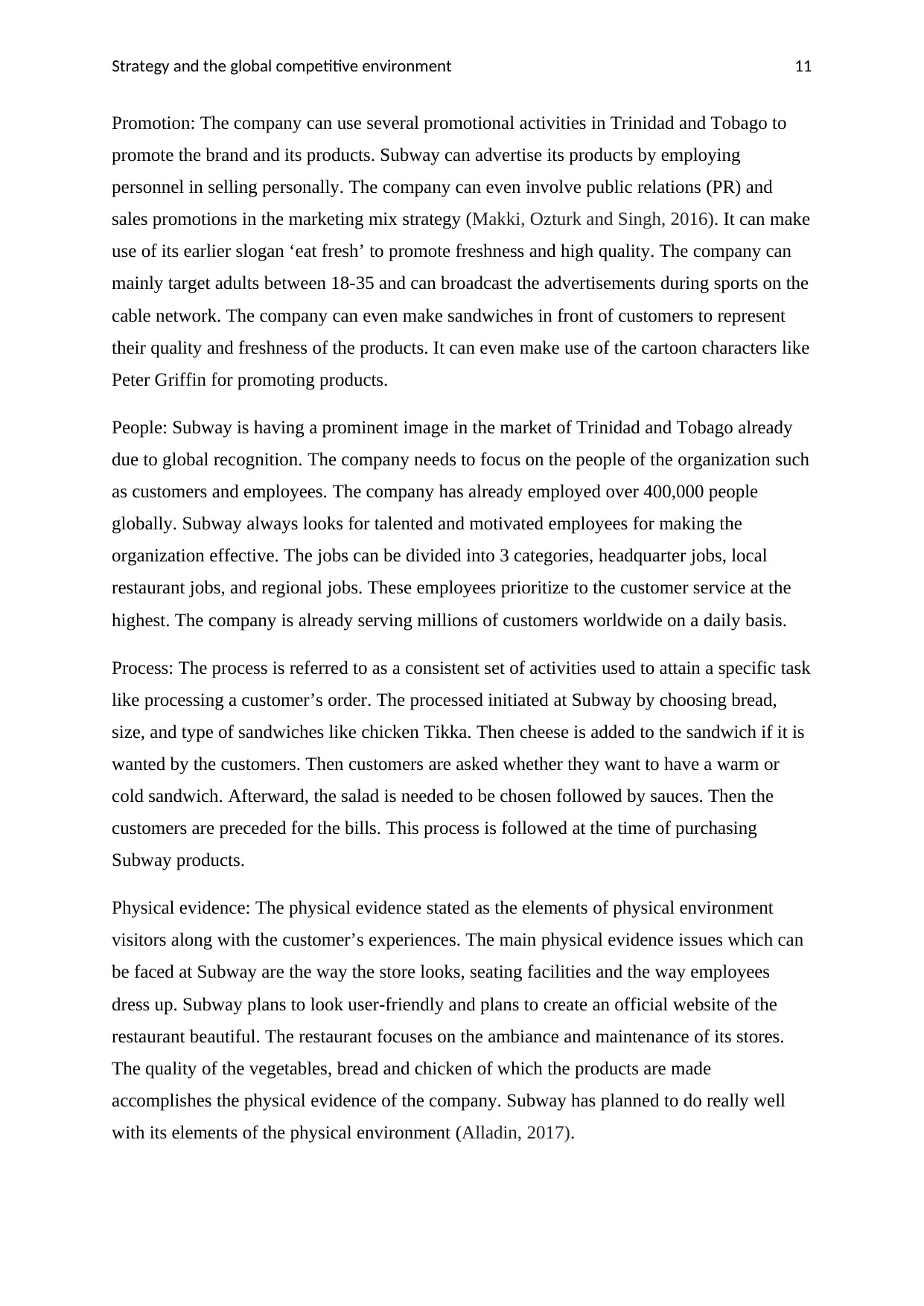
Strategy and the global competitive environment 11
Promotion: The company can use several promotional activities in Trinidad and Tobago to
promote the brand and its products. Subway can advertise its products by employing
personnel in selling personally. The company can even involve public relations (PR) and
sales promotions in the marketing mix strategy (Makki, Ozturk and Singh, 2016). It can make
use of its earlier slogan ‘eat fresh’ to promote freshness and high quality. The company can
mainly target adults between 18-35 and can broadcast the advertisements during sports on the
cable network. The company can even make sandwiches in front of customers to represent
their quality and freshness of the products. It can even make use of the cartoon characters like
Peter Griffin for promoting products.
People: Subway is having a prominent image in the market of Trinidad and Tobago already
due to global recognition. The company needs to focus on the people of the organization such
as customers and employees. The company has already employed over 400,000 people
globally. Subway always looks for talented and motivated employees for making the
organization effective. The jobs can be divided into 3 categories, headquarter jobs, local
restaurant jobs, and regional jobs. These employees prioritize to the customer service at the
highest. The company is already serving millions of customers worldwide on a daily basis.
Process: The process is referred to as a consistent set of activities used to attain a specific task
like processing a customer’s order. The processed initiated at Subway by choosing bread,
size, and type of sandwiches like chicken Tikka. Then cheese is added to the sandwich if it is
wanted by the customers. Then customers are asked whether they want to have a warm or
cold sandwich. Afterward, the salad is needed to be chosen followed by sauces. Then the
customers are preceded for the bills. This process is followed at the time of purchasing
Subway products.
Physical evidence: The physical evidence stated as the elements of physical environment
visitors along with the customer’s experiences. The main physical evidence issues which can
be faced at Subway are the way the store looks, seating facilities and the way employees
dress up. Subway plans to look user-friendly and plans to create an official website of the
restaurant beautiful. The restaurant focuses on the ambiance and maintenance of its stores.
The quality of the vegetables, bread and chicken of which the products are made
accomplishes the physical evidence of the company. Subway has planned to do really well
with its elements of the physical environment (Alladin, 2017).
Promotion: The company can use several promotional activities in Trinidad and Tobago to
promote the brand and its products. Subway can advertise its products by employing
personnel in selling personally. The company can even involve public relations (PR) and
sales promotions in the marketing mix strategy (Makki, Ozturk and Singh, 2016). It can make
use of its earlier slogan ‘eat fresh’ to promote freshness and high quality. The company can
mainly target adults between 18-35 and can broadcast the advertisements during sports on the
cable network. The company can even make sandwiches in front of customers to represent
their quality and freshness of the products. It can even make use of the cartoon characters like
Peter Griffin for promoting products.
People: Subway is having a prominent image in the market of Trinidad and Tobago already
due to global recognition. The company needs to focus on the people of the organization such
as customers and employees. The company has already employed over 400,000 people
globally. Subway always looks for talented and motivated employees for making the
organization effective. The jobs can be divided into 3 categories, headquarter jobs, local
restaurant jobs, and regional jobs. These employees prioritize to the customer service at the
highest. The company is already serving millions of customers worldwide on a daily basis.
Process: The process is referred to as a consistent set of activities used to attain a specific task
like processing a customer’s order. The processed initiated at Subway by choosing bread,
size, and type of sandwiches like chicken Tikka. Then cheese is added to the sandwich if it is
wanted by the customers. Then customers are asked whether they want to have a warm or
cold sandwich. Afterward, the salad is needed to be chosen followed by sauces. Then the
customers are preceded for the bills. This process is followed at the time of purchasing
Subway products.
Physical evidence: The physical evidence stated as the elements of physical environment
visitors along with the customer’s experiences. The main physical evidence issues which can
be faced at Subway are the way the store looks, seating facilities and the way employees
dress up. Subway plans to look user-friendly and plans to create an official website of the
restaurant beautiful. The restaurant focuses on the ambiance and maintenance of its stores.
The quality of the vegetables, bread and chicken of which the products are made
accomplishes the physical evidence of the company. Subway has planned to do really well
with its elements of the physical environment (Alladin, 2017).
⊘ This is a preview!⊘
Do you want full access?
Subscribe today to unlock all pages.

Trusted by 1+ million students worldwide
1 out of 18
Related Documents
Your All-in-One AI-Powered Toolkit for Academic Success.
+13062052269
info@desklib.com
Available 24*7 on WhatsApp / Email
![[object Object]](/_next/static/media/star-bottom.7253800d.svg)
Unlock your academic potential
Copyright © 2020–2025 A2Z Services. All Rights Reserved. Developed and managed by ZUCOL.





